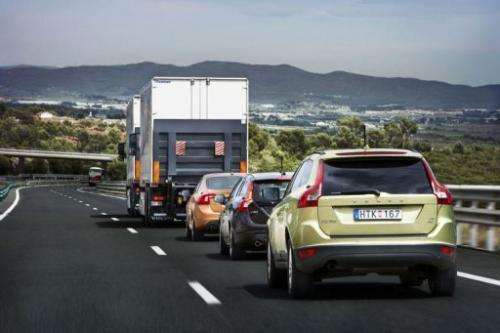A picture taken on May 22, 2012 and released on May 29 shows a convoy of self-driving cars on a public motorway near Barcelona, Spain. The convoy of self-driving cars took to the motorway in normal traffic, a world first, according to Swedish car maker Volvo.
(Phys.org) -- In the annals of “whatever happened to that big idea” is the 2009 announcement of road trains linking cars in a convoy, a scheme planned for Europe’s motorways. The lead vehicle would have the active driver and the rest of the cars in the convoy would be autonomously driven. Someone, possibly with a sense of humor, dubbed the undertaking as the Sartre Project, standing for Safe Road Trains for the Environment. This month comes the report that the idea has been successfully tested and is a step forward in a plan to change the way vehicles travel.
Reports are out that a convoy of self-driven vehicles last week completed a 125-mile trip on a Spanish motorway, just outside of Barcelona, in the first public test of such convoy vehicles.
The Sartre project, focused on motorways, is being funded by the European Commission. The concept is driven by principles that vehicle convoys, or “platoons,” can reduce fuel consumption (some estimates say by around 20 percent) and can result in fewer accidents.
Volvo pulled this off in this month’s Spain test by deploying cars, a Volvo XC60, a Volvo V60 and a Volvo S60, plus one truck. A professional driver took the lead in a truck, and was followed by the four self-driven Volvo vehicles: a second truck and the three cars.
The cars were in a queue using the lead car as the pace setter. The vehicles were wirelessly linked to each other and all drove at 52mph with the gap between each vehicle of about 19 feet. The test run is significant as it was deployed in realtime among other road users.
Autonomous-driving features outfitted in the cars included radar, laser sensors, and cameras. With wireless communication, the vehicles were able to mimic the lead vehicle, accelerating, braking, and turning in the same way as the lead vehicle.
Other partners in the project alongside Volvo include Ricardo UK, Idiada and Robotiker-Tecnalia of Spain, Institut fur Kraftfahrzeuge Aachen (IKA) of Germany and SP Technical Research Institute of Sweden.
The Sartre project, along with Google’s self-driving car tests in the US, signify that autonomous driving in whatever construct is out of the science-fiction straightjacket and on the books. A race is on, say observers, to create a different kind of auto industry. However, while technology components are there, Sartre Project leaders note the idea is still dependent on legislation and user acceptance, question-marks that will impact the date for introduction of car platoons to market. The Sartre Project, where early adoption might involve formation of dedicated lanes for the convoys, has no specific date for completion of the project. Those in the Sartre Project acknowledge a lot of challenges for analysis, but the Spain test is considered an auspicious start.
More information: www.sartre-project.eu/en/Sidor/default.aspx
© 2012 Phys.Org























